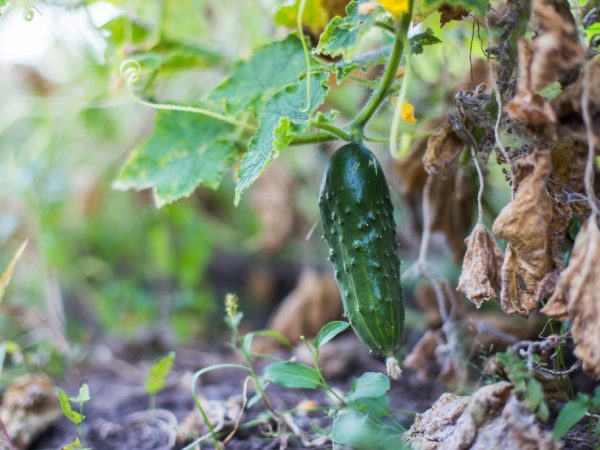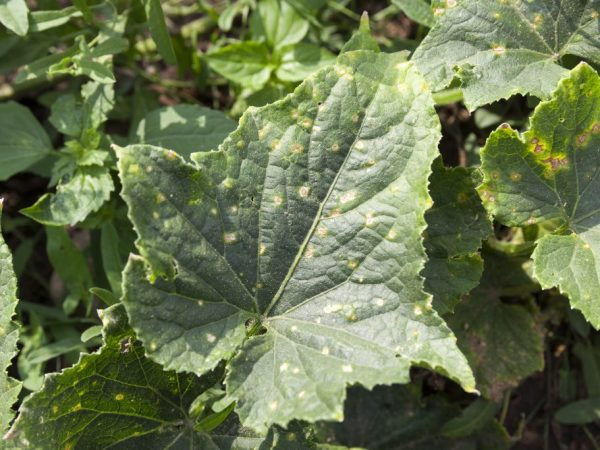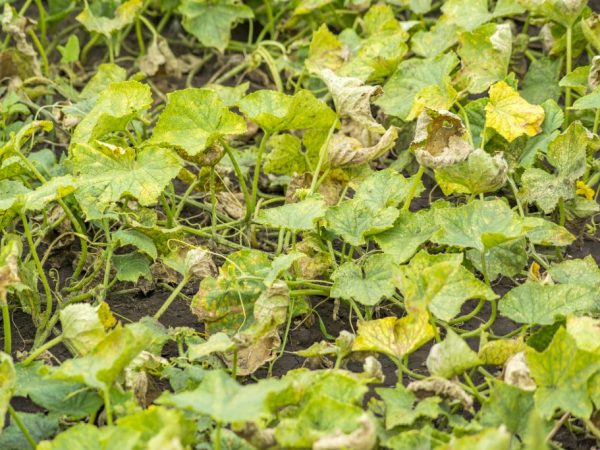Why do cucumber leaves turn white and dry
Not every gardener knows why cucumber leaves turn white and dry. Let's consider the causes of the problem and how to fix it.

Causes of whitening and drying of leaves
Main reasons
The reason why the leaves of cucumbers turn white can be both disease and pests, as well as improper care.
Wrong agricultural technique
The main mistakes of gardeners in caring for plants:
- planting too early in the ground;
- watering young plants with cold water;
- unsuitable soil for acidity.
All these nuances eventually lead to whitening of the leaves of cucumbers.
Drop off time
It is necessary to plant a culture in open ground no earlier than the first 10 days of April, otherwise the seeds and the first shoots will freeze, barely showing up on the surface of the soil.
Watering
Young cucumber bushes are watered with slightly warm water at a temperature of about 20-25 ° C: this helps the plants adapt faster and accelerates their growth without compromising health.
Acidity
Too high acidity also plays a significant role in the fact that the leaves of the plant turn pale and growth stops.
Before planting seeds in open soil, check the acidity level of the soil: put a handful of earth in a plastic container, pour distilled water into it so that the soil becomes viscous, add 1 tsp there. baking soda. If the mixture fizzes and bubbles, the soil PH is high. An ash solution will help neutralize high acidity.
Place 250 g of ash in 5 liters of water, stir thoroughly to achieve a homogeneous mixture. The ready-made solution is used for watering the wells during the planting period.
Diseases and pests
The first signs that the plant has been affected by pests or disease are dryness and whitening of the leaves. Among the main diseases and parasites that have a negative effect on cucumber bushes are:
- powdery mildew;
- white mosaic;
- ascochitis;
- spider mite;
- anthracnose.
Powdery mildew
The most common cause of white spots on cucumber leaves is powdery mildew. This is a fungal disease. Most often, infection occurs in the greenhouse, because there are the best conditions for the development of Erysiphales. White spots appear on the leaves, young shoots, stems, and sometimes on the fruits, similar to drops of moisture.
To prevent the disease, watering is closely monitored: they moisten the ground near the plant, trying not to get on the leaves. If the cucumbers are grown in a greenhouse, it should be covered overnight to avoid extreme temperature fluctuations.
White mosaic

You need to start treatment as soon as possible
White mosaic is the second most common disease affecting cucumbers. This viral-fungal disease differs in that the spots on the leaves are star-shaped, which causes the leaves to dry.
The disease affects even the cotyledonous leaves. If nothing is done, the infected plant dies.
Ascochitosis
Another parasite of cucumbers is ascochytosis, caused by a group of imperfect fungi that belong to the genus Ascochyta.Signs of the influence of this pest:
- the tips of the leaves, and sometimes the stems, are covered with small spots of yellowish color;
- leaves change color to dirty gray;
- the spots increase in size. sometimes take up most of the sheet.
As a result, the leaves of cucumbers dry up, sometimes they can even shrivel.
Spider mite
A spider mite is a pest that is less than 1 mm in size. It often becomes the reason why cucumber leaves dry. The bottom sheets are affected first. The danger is that insects of this species multiply very quickly: a female can lay up to 400 eggs in a few days.
Anthracnose
Anthracnose is a fungal disease. From its negative influence, not only leaves dry, but also stems and shoots. Yellowish or brownish spots appear from about 3 mm to 3-4 cm.
Most often, the edges of the leaves are affected. With a large lesion, the spots merge. Ulcers form in the affected areas. Sometimes the leaf just breaks apart.
Plants grown in greenhouses are most susceptible to anthracnose. there is a limited space into which it is convenient for the pathogen to migrate.
Control methods
If the sheets or at least their edges have turned white from the effects of any disease, they use radical methods of struggle.
Inventory handling
The first control measure is the destruction of all infected plants, even at the slightest sign of pest infestation. If the bush is severely damaged, it is removed with the stem.
All gardening equipment (hoes, shovels, rakes) is treated with a 5% solution of potassium permanganate.
For prevention, crop rotation is not neglected. Every year, different types of crops are changed in places on the garden plot.
Powdery mildew

Diseased plants must be destroyed
If the cucumber bushes are struck by powdery mildew, you need:
- Destroy all infected plants.
- Treat the plot of land and healthy cucumbers with Topaz solution. To prepare it, dilute one ampoule of the substance in 10 liters of water. Treatment is carried out by drip irrigation.
- Use manure. It is mixed with water in a ratio of 1: 3, after which it is defended for 3 days, filtered through cheesecloth and added to 3 liters of water. This amount of solution is enough to process 1 sq. m beds.
Ascochitosis
It is best to use fungicides to combat ascochitis. Bordeaux fluid is most effective.
For its preparation, 100 g of copper sulfate and 100 g of slaked lime are taken for 10 liters. You can also use the ready-made mixture in powder, dissolving it at a concentration of 1%. This amount of solution is enough for 10-15 adult cucumber bushes.
For prevention, you need to monitor the humidity of the air. Cucumbers themselves love water, but high humidity creates favorable conditions for the development of various fungal diseases.
Preventive measures
Usually, the leaves of cucumbers grown in greenhouses and greenhouses turn white and dry. This is facilitated by the limited area and poor supply of fresh air, lack of crop rotation. It is important even before construction to take measures to prevent the development of pathogenic fungi and insects.
Greenhouse
The design of the greenhouse must be provided with ventilation windows so that through ventilation is possible. The greenhouse itself should not be exposed to direct sunlight all day long. If this condition is difficult to comply with, one side is covered with agrofibre. It is a special non-woven fabric with anti-UV treatment.
Another point in the construction of a greenhouse is a strong protection against moisture ingress during rain. Strong droplets or streams of moisture can clog the soil and restrict the supply of oxygen to the roots.
Fungi
The struggle for the harvest under the influence of a spider mite is more difficult than in a situation with fungal diseases. The tick larva is resistant to adverse conditions, therefore it is so important to follow all preventive measures in order to avoid complete drying of the plant
- if possible, change the place of planting of cucumbers;
- maintain humidity 80-90%;
- inspect plants as often as possible for ticks (especially the lower leaves);
- in autumn, carefully remove plant residues, prepare the soil in advance for the next planting season.
Other methods
Other safeguards include a number of actions:
- collect seeds only from healthy plants;
- disinfect the structures and soil of greenhouses;
- apply biological products and organic fertilizers.
The main thing is to identify and remove diseased plants in time. You can spray the planting site of cucumbers with preparations of the Bordeaux mixture, copper oxychloride, abiga-kick.
Conclusion
Cucumber leaves often turn white and dry for 2 reasons: poor-quality care or the negative influence of pests. To prevent this, you need to take preventive measures in time: observe crop rotation, collect seeds only from healthy vegetables, etc. Traditional methods and chemicals are used as pest control.


